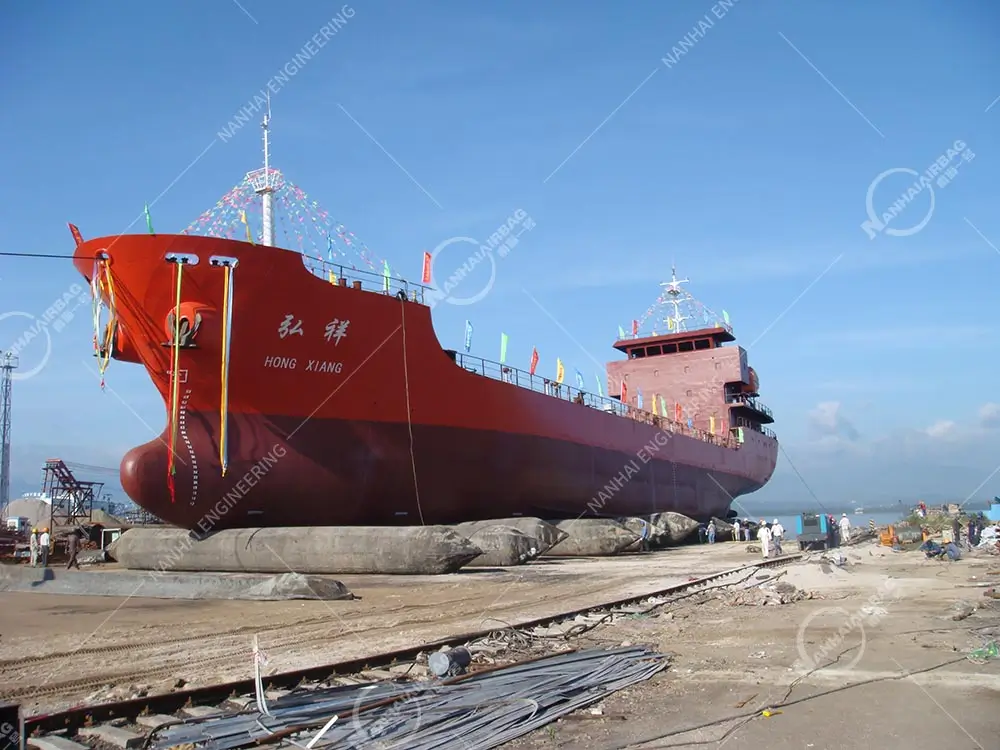NANHAI mejora los materiales de caucho para cumplir las normas EUDR
09/05/2025Defensas neumáticas de caucho de alta calidad
09/09/2025Mejor método de botadura de buques para pequeños astilleros 2025
En 2025, los astilleros pequeños y medianos se enfrentan a una presión cada vez mayor para entregar los buques de forma segura, eficiente y puntual. Los presupuestos limitados, el espacio restringido y las estrictas normas de seguridad hacen que la elección de métodos de botadura de buques más crítico que nunca. Entre varias opciones, airbags de lanzamiento de barcos se han convertido en la solución más rentable y flexible para los astilleros pequeños y medianos de todo el mundo.

1. Escenarios típicos
Imaginemos que un buque pesquero de 5.000 TPM está listo para su entrega en un astillero de tamaño medio de Zhejiang. El astillero tiene un espacio limitado y carece de grada tradicional. El plazo de entrega es ajustado y cualquier retraso podría causar graves pérdidas.
Los astilleros en situaciones similares suelen enfrentarse a tres retos principales:
- Seguridad - proteger el buque durante la botadura
- Control de costes - evitar costosas mejoras de las infraestructuras
- Plazos ajustados - cumplir los plazos para garantizar la confianza de los clientes
2. Objetivos y tareas clave
Elegir y aplicar los mejores método de botadura de buquesLos astilleros deben seguir estos pasos:
2.1 Evaluar las condiciones del patio
- Medir la longitud disponible de la grada, el ángulo y la resistencia del suelo.
- Compruebe la profundidad del agua, las mareas y las ventanas operativas
- Evalúe si el sitio admite varias opciones de lanzamiento
2.2 Elegir la tecnología de lanzamiento adecuada
Comparar los más comunes métodos de botadura de buques:
- VaraderoEstable, pero requiere grandes inversiones e instalaciones fijas
- Airbags de lanzamiento de barcosflexible, rentable, reutilizable e ideal para buques de distintos tamaños
- Varadero flotanteAdecuado para grandes buques, pero más complejo
- Grúas o sistemas de elevacióneficientes para embarcaciones pequeñas, pero requieren equipos caros
2.3 Preparar el plan de lanzamiento
- Diseñar un flujo de trabajo detallado paso a paso
- Establecer medidas de seguridad y planes de emergencia
- Asignar responsabilidades claras y preparar las herramientas con antelación
2.4 Adquisición o modernización de equipos
- Obtenga el airbags de lanzamiento de barcoscabrestantes y sistemas de remolque
- Garantizar que todos los equipos cumplen las normas de seguridad más recientes
2.5 Ejecutar el lanzamiento
- Siga el plan paso a paso
- Control de la posición y las fuerzas del buque en tiempo real
- Manejar situaciones inesperadas con rapidez y seguridad
3. Retos y obstáculos
| Escenario | Problema principal | Impacto | Problema típico |
|---|---|---|---|
| Evaluación del patio | Falta de datos precisos | Análisis de viabilidad erróneo | Elección de métodos inadecuados |
| Elección de tecnología | Información de mercado obsoleta | Mayores costes o riesgos | Utilizar soluciones caras |
| Planificación de la seguridad | No existen procedimientos normalizados | Mayores riesgos de lanzamiento | Incidentes frecuentes |
| Adquisición de equipos | Presupuestos limitados | Es difícil equilibrar coste y calidad | Comprar herramientas de baja calidad |
| Proceso de lanzamiento | Sin control en tiempo real | Respuesta de emergencia lenta | Daños o retrasos del buque |
4. Pruebas y casos prácticos
Datos del sector
- Según el informe de 2025 de la Asociación China de la Industria Nacional de Construcción Naval (CANSI), más de 1.000 millones de euros se destinarán a la construcción naval. 70% de astilleros pequeños y medianos ahora prefiero airbags de lanzamiento de barcos.
- El Directrices 2025 de la Asociación Internacional de Sociedades de Clasificación (IACS) recomiendan los airbags como método seguro y eficaz para buques de menos de 10.000 TPM.
Casos de éxito
- Caso 1 - Astillero pesquero de Zhejiang
Se ha pasado de la botadura en grada a airbags de lanzamiento de barcos.- Reducción de los costes de equipamiento en 30%
- Eficacia de lanzamiento mejorada por 40%
Más información sobre airbags de lanzamiento de buques →
- Caso 2 - Jiangsu Workboat Yard
Adoptó un método de lanzamiento híbrido (grada + airbags).- Resuelto el problema de la pendiente insuficiente
- Garantizó la entrega segura y sin contratiempos de los buques
Descubra las soluciones de NANHAI →
5. Conclusión y recomendación
Para la mayoría de los astilleros pequeños y medianos en 2025, la mejor solución es:
- First Choice - Airbags de lanzamiento de barcos
- Baja inversión y alta flexibilidad
- Reutilizable, seguro y adecuado para varios tipos de recipientes
- Segunda opción: botadura en varadero
- Ideal si ya existen instalaciones fijas
- Soluciones opcionales - Muelles flotantes y grúas
- Adecuado para diseños de recipientes especiales o proyectos premium
En NANHAIEstamos especializados en el diseño y la fabricación de airbags de lanzamiento de buques de alta calidad. Nuestros productos ayudan a los astilleros de todo el mundo reducir costes, mejorar la eficacia y garantizar la seguridad.
Más información sobre los airbags de lanzamiento de buques NANHAI
